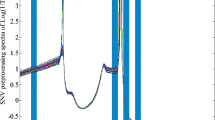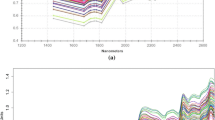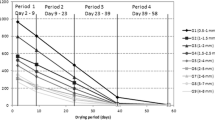Abstract
The feasibility of measuring moisture content in green tea by Fourier transform near infrared (FTNIR) spectroscopic technique was investigated. Green tea granules samples with different moisture contents were scanned using FTNIR spectroscopy. The spectra were measured in diffused reflectance mode by keeping 4–5 g samples in small sample bottle. A partial least-square regression model was developed with vector normalization method in the near-infrared region (4,000–12,000 cm−1 or 800–2,500 nm). The developed model was validated using cross-validation technique. Maximum coefficient of determination (r 2) value of 0.997 was obtained for the calibration model developed. The developed method was used further for quantification of moisture content in fresh green tea samples, and the results were compared with other methods like gravimetric method and moisture analyzer. Results indicated that FTNIR spectroscopy could be used for rapid detection of moisture content in green tea granules without destruction of samples. The measurement will take only 5–10 s.





Similar content being viewed by others
References
BIS. SP: 18: (1981). Handbook of Food Analysis Part XI: Dairy Products. Bureau of Indian Standards, New Delhi
Brain, B. P. (2001). Preliminary analysis of the advantages and limitations of a stationary imaging Fourier transform spectrometer, 2001 NASA-ODU American Society for Engineering Education (ASEE) Summer Faculty Fellowship Program, p. 48.
Chen, Q., Shao, J., Shang, H., & Wang, X. (2006). Feasibility study on qualitative and quantitative analysis in tea by near infrared spectroscopy with multivariate calibration. Analytica Chimica Acta, 572, 77–84. doi:10.1016/j.aca.2006.05.007.
Chen, Q., Zhao, J., Fang, C. H., & Wang, D. (2007). Feasibility study on identification of green, black and Oolong teas using near-infrared reflectance spectroscopy based on support vector machine (SVM). Spectrochimica Acta. Part A, 66, 568–574.
Fujiki, H., Suganuma, M., Okabe, S., Sueoka, E., Sueoka, N., Fujimoto, N., et al. (2001). Cancer prevention with green tea and monitoring by a new biomarker, hnRNP B1. Mutation Research, 480–481, 299–304. doi:10.1016/S0027-5107(01)00189-0.
Jian, L., Xie, L. P., Lee, A. H., & Binns, C. W. (2004). Protective effect of green tea against prostate cancer: a case-control study in southeast China. International Journal of Cancer, 108, 130–135. doi:10.1002/ijc.11550.
Li, X., and He, Y. (2008). Evaluation of least squares support vector machine regression and other multivariate calibrations in determination of internal attributes of tea beverages. Food Bioprocess Technol. In press. doi:10.1007/s11947-008-0101-y.
Luypaert, J., Zhang, M. H., & Massart, D. L. (2003). Feasibility study for using near infrared spectroscopy in the qualitative and quantitative of green tea, Camellia sinensis (L). Analytica Chimica Acta, 487, 303–312. doi:10.1016/S0003-2670(02)01509-X.
McShane, M. J., & Cote, G. L. (1998). Near-infrared spectroscopy for determination of glucose lactate, and ammonia in cell culture media. Applied Spectroscopy, 52, 1073–1078. doi:10.1366/0003702981944968.
Nakachi, K., Matsuyama, S., Miyake, S., Suganuma, M., & Imai, K. (2000). Preventive effects of drinking green tea on cancer and cardiovascular disease: epidemiological evidence for multiple targeting prevention. Biofactors, 13, 49–54.
Nieuwoudt, H. H., Pretorius, I. S., Bauer, F. F., Nel, D. G., & Prior, B. A. (2006). Rapid screening of the fermentation profiles of wine yeasts by Fourier transform infrared spectroscopy. Journal of Microbiological Methods, 67, 248–256. doi:10.1016/j.mimet.2006.03.019.
Pink, J., Naczk, M., & Pink, D. (1998). Evaluation of the quality of frozen minced red hake: use of Fourier transform infrared spectroscopy. Journal of Agricultural and Food Chemistry, 46, 3667–3672. doi:10.1021/jf980395u.
Sahay, K. M., & Singh, K. K. (1994). Unit operations of agricultural processing. New Delhi: Vikas Publishing House PVT LTD.
Schulz, H., Engelhardt, U. H., Wengent, A., Drews, H. H., & Lapczynski, S. (1999). Application of NIRS to the simultaneous prediction alkaloids and phenolic substance in green tea leaves. Journal of Agricultural and Food Chemistry, 475, 5064–5067. doi:10.1021/jf9813743.
Setiawan, V. W., Zhang, Z. F., Yu, G. P., & Lu, Q. Y. (2001). Protective effect of green tea on the risks of chronic gastritis and stomach cancer. International Journal of Cancer, 92(4), 600–604. doi:10.1002/ijc.1231.
Shibata, K., Moriyama, M., Fukushima, T., Kaetsu, A., Miyazaki, M., & Une, H. (2000). Green tea consumption and chronic atrophic gastritis: a cross-sectional study in a green tea production village. Journal of Epidemiology, 10(5), 310–316.
Williams, P., & Norris, K. (2001). Near-infrared technology in the agricultural and food industries p. 167. St Paul, MN, USA: American Association of Cereal Chemist.
Woodcock, T., Fagan, C. C., O’Donnell, C. P., & Downey, G. (2008). Application of near and mid-infrared spectroscopy to determine cheese quality and authenticity. Food Bioprocess Technol, 1, 117–129. doi:10.1007/s11947-007-0033-y.
Yang, C. S., Maliakal, P., & Meng, X. (2002). Green tea polyphenols: antioxidative and prooxidative effects. Annual Review of Pharmacology and Toxicology, 42, 25–54.
Zhang, M. H., Luypaert, J., Xu, Q. S., & Massart, D. L. (2004). Determination of total antioxidant capacity in green tea by NIRS and multivariate calibration. Talanta, 62, 25–35. doi:10.1016/S0039-9140(03)00397-7.
Acknowledgment
The first author is thankful to All India Council for Technical Education (AICTE) New Delhi, for the financial assistance received in the form of National Doctoral Fellowship to pursue her Doctoral programme.
Author information
Authors and Affiliations
Corresponding author
Rights and permissions
About this article
Cite this article
Sinija, V.R., Mishra, H.N. FTNIR Spectroscopic Method for Determination of Moisture Content in Green Tea Granules. Food Bioprocess Technol 4, 136–141 (2011). https://doi.org/10.1007/s11947-008-0149-8
Received:
Accepted:
Published:
Issue Date:
DOI: https://doi.org/10.1007/s11947-008-0149-8




